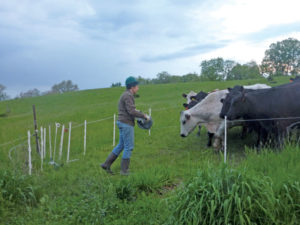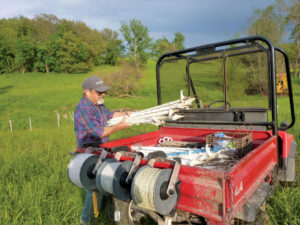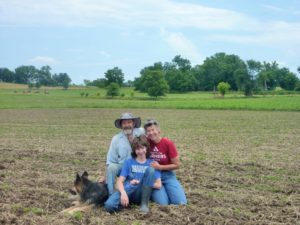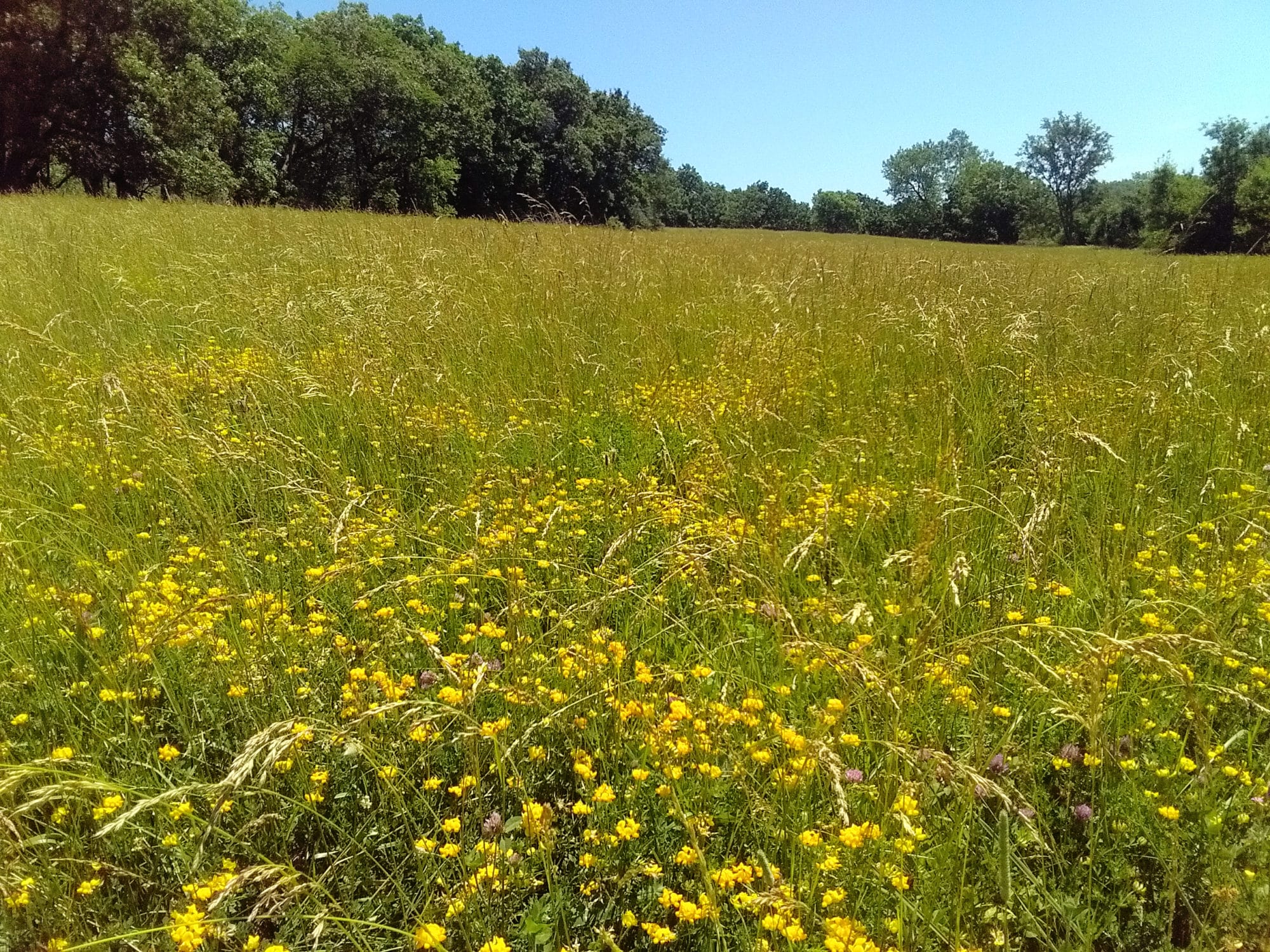Partners in Life and Land
Barney Bahrenfuse and Suzanne Castello are transforming their midsized farm, creating greater harmony with the land.
Barney Bahrenfuse and Suzanne Castello’s journey as a couple began at a PFI annual conference over two decades ago, where a “chance encounter” led to a lasting connection. For the past 18 years, the pair have been farming side by side, building both their lives and their farm.
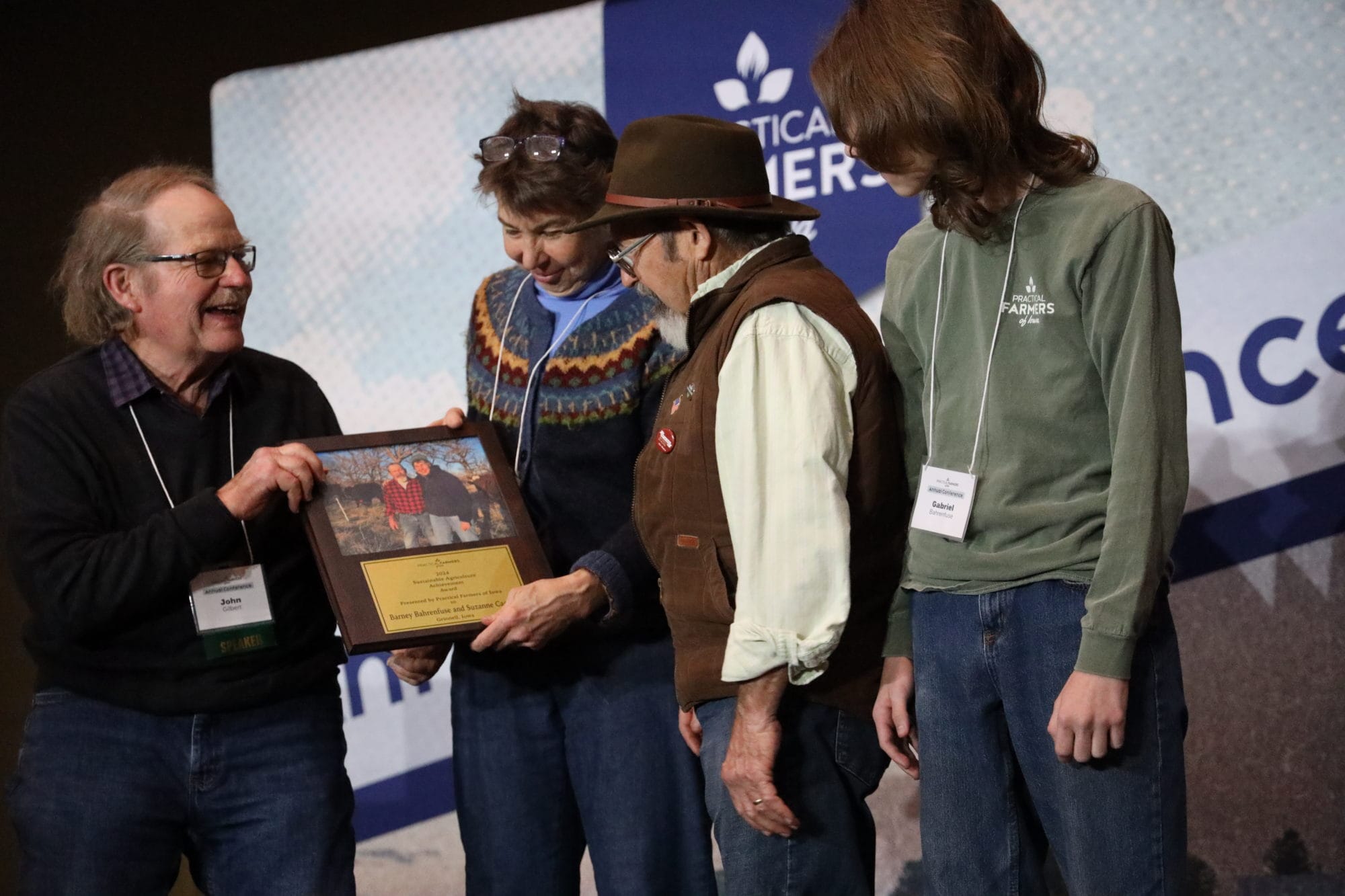
John Gilbert Sr. presents PFI’s 2025 Sustainable Agriculture Achievement Award to Suzanne, Barney and their son, Gabe.
Today, Barney and Suzanne, along with their teenage son, Gabe, run a 500-acre diversified crop and livestock farm near Grinnell, Iowa. Their vision for the farm is as clear as it is inspiring – to create a landscape that prioritizes diversity, nurtures the land and provides for their community.
“Diversification is key,” Barney says, “both for regenerating the soil and habitat, but also as an economic safety net.”
This emphasis on diversity is evident in the couple’s farm enterprises, which include cattle, sheep, chickens and hogs, and certified organic corn, oats, hay and soybeans. Most of the grains they use as feed for their livestock, though they sell a portion of their organic soybeans off the farm, as well as some meat to local customers.
In January, Suzanne and Barney received PFI’s 2025 Sustainable Agriculture Achievement Award for their dedication to innovation and sustainability. The award is given each year by PFI to an individual or couple that has shown exemplary commitment to sustainable agriculture, generously shared their knowledge with others and been influential in efforts to foster vibrant communities, diverse farms and healthy food.
Longtime member John Gilbert presented the award. He and his family run a diversified crop and livestock farm near Iowa Falls, Iowa, and were early farming mentors to Suzanne as she sought to learn about sustainable agriculture. The two families remain close friends today.
“The meaning of sustainability has long been debated, but one aspect that rarely gets attention is the need and desire to do things the right way, even when that isn’t the easiest way or the way everybody else does it,” John says. “If anything should be evident about Barney and Suzanne, it’s that their understanding of what is right is defined by what is best for their soil, animals, customers, community, environment and farming livelihoods.”
A Commitment to Sustainability
Suzanne and Barney run a predominantly pasture-based farm. To build diversity and soil health, they plant a diversified, long rotation of
oats, hay, corn, soybeans and cover crops. “Our crop ground is intentionally broken up into smaller fields, averaging about 12 acres each,” Barney says. This ensures that rarely do two adjacent fields get tilled up in any one year, limiting the chance for erosion.
As part of nourishing the soil, they add green manure, a term describing crops that are worked into the soil while still green. To do this, Barney and Suzanne use a rotavator, which lets them mix large amounts of green manure into the soil with minimal disturbance. They have also experimented with “two-on-two corn,” also known as skip-row planting. In this technique, two rows of corn are planted and two rows are unplanted. In the skipped rows, they plant a cover crop to improve biodiversity and nutrient cycling.
Livestock, however, are the heartbeat of their farm – and the reason they farm. Suzanne and Barney are most proud of the mob grazing technique they use for their cattle, which mimics the natural grazing patterns of bison that once roamed the prairie. On Iowa’s past landscape, large herds of bison grazed intensively in one area briefly before moving on, allowing the land to rest and recover.
To replicate this, Suzanne and Barney use temporary electric fences to concentrate their cattle into small areas. Then, by putting up new
fences, they move the cattle progressively through the pasture, a couple of acres at a time, striving to maintain a 90-day rest period. Suzanne says this technique supports wildlife like grassland birds, pollinators and native prairie species. “It’s a joy seeing how much the cows appreciate getting new grass,” she says with a smile. “We’ve learned so much about our land and the species living on it by using this technique.”
Throughout the years, she and Barney have tried just about every type of agricultural technique. After years of trial and error, the couple now has a set of practices they like and that work for their farm.
“I am so happy with what we’re doing with our soil,” Barney says. “To me, that’s what means the most.”
The pair are now working toward grass-finishing all their beef and converting more land to grass. They’re also exploring ways to create more habitat on their farm, including planting trees and converting certain areas to prairie.
Unexpected Beginnings
The couple’s path into farming wasn’t conventional. Suzanne, a California native, first fell in love with Iowa while attending Grinnell College in the 1980s. Over the next 20 years, she returned several summers to work on both produce and livestock farms. It didn’t take long for her to discover that her true passion was in livestock. “I got addicted to taking care of animals,” she says.
Eager to learn more, she reached out to John Gilbert and his wife, Bev, who received PFI’s 2017 Sustainable Agriculture Achievement Award. Suzanne recalls how they took her under their wing, teaching her the art of raising pigs while sharing their expertise in sustainable crop farming and animal husbandry.
Barney grew up on the same land they farm today and had no intention of coming back after he left in the ‘70s. He worked in the trades, taking on a variety of jobs in plumbing, electrical work, wastewater management and more. He also spent time working on a ranch in Colorado and Wyoming. But in the early 1980s, he returned home. “I wanted to work for myself and do something different every day,” he says.
When he came back, he continued the type of farming he had grown up with – long rotations that were occasionally sprayed with herbicides. Barney credits the Farm 2000 project, led by PFI member Steve Hopkins, and the larger PFI community, with opening his eyes to alternative practices. When their paths first crossed at the PFI annual conference in 2004, he and Suzanne were already PFI members. Barney was volunteering at the registration booth. When Suzanne stopped by the booth, she immediately caught his eye. “I was interested, and I pursued it,” Barney chuckles. “Oh, I could tell he was smitten,” Suzanne adds.
The chance encounter sparked a lasting connection, and the two have been farming together – and married – for 18 years. They agree they complement each other perfectly and say they have created a strong farming partnership. Barney praises Suzanne’s creativity and research skills. “She’s great at investigating and coming up with the different cover crop mixes, and looking into ways to improve our soil biology,” he says. Suzanne, in turn, applauds Barney for his efficiency and mechanical expertise. Together, their unique skills and talents drive the success of their farm.
Leading by Example
The couple’s innovative spirit and commitment to sustainability have influenced others, from neighbors to students visiting their farm. “We want to help people that are starting out or transitioning see a way they can make a living that is not just corn and soybeans on many acres,” Suzanne says.
She and Barney are heartened by the experimentation of a new generation of farmers. Their advice to these farmers is to surround themselves with people who are pursuing alternative paths and aren’t afraid to be different. They also note the importance of having a community in farming, and people you can call on. “Knowing that you have someone else to talk to, it’s worth so much,” Barney says. From hosting field days for PFI to reaching out to others to make them feel welcome and included, Suzanne and Barney have tried to be those people for others.
They also pay close attention to what’s happening on their farm.
“Farming the way we do is about listening and asking, ‘What does the land want?’” Suzanne says. Barney agrees, adding, “It’s all about diversity – diversity of people, plants and bugs. When there’s more diversity, things are better.”

